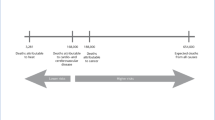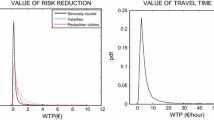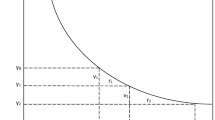Abstract
We report on the results of a survey based on conjoint choice experiments that was specifically designed to investigate the effect of context on the Value of a Statistical Life (VSL), an important input into the calculation of the mortality benefits of environmental policies that reduce premature mortality. We define “context” broadly to include (1) the cause of death (respiratory illness, cancer, road traffic accident), (2) the beneficiary of the risk reduction (adult v. child), and (3) the mode of provision of the risk reduction (public program v. private good). The survey was conducted following similar protocols in Italy and the Czech Republic. When do not distinguish for the cause of death, child and adult VSL are not significantly different from one another in Italy, and the difference is weak in the Czech sample. When we distinguish for the cause of death, we find that child and adult VSLs are different at the 1% level for respiratory illnesses and road-traffic accidents, but do not differ for cancer risks. We find evidence of a “cancer premium” and a “public program premium.” In both countries, the marginal utility of income is about 20% lower among wealthier people, which makes the VSL about 20% higher among respondents with incomes above the sample average. The discount rate implicit in people’s choices is effectively zero. We conclude that there is heterogeneity in the VSL, and that such heterogeneity is primarily driven by risk characteristics mode of delivery of the risk reduction, and income, while other individual characteristics of the respondent (e.g., age and education) are less important. For the most part, our results are in agreement with environmental policy analyses that use the same VSL for children and adults, and that apply a cancer premium.
Similar content being viewed by others
References
Agee MD, Crocker TD (2001) “Smoking Parents’ Valuations of Own and Children’s Health,” Paper presented at the association of environmental and resource economists conference, Bar Harbour, Maine, June
Alberini A, Cropper ML, Krupnick A, Simon N (2004) Does the value of a statistical life vary with age and health status? Evidence from the U.S. and Canada. J Environ Econ Manage 48(1): 769–792
Alberini A, Ščasný M, Kohlová MB, Melichar J (2006) The value of statistical life in the Czech Republic: evidence from contingent valuation study. In: Menne B, Ebi KL (eds) Climate change and adaptation strategies for human health. Springer, Steinhopff Verlag, Darmstadt, pp 373-393. ISBN: 3-7985-1591-3
Alberini A, Chiabai A (2007a) Urban environmental health and sensitive populations: how much are the Italians willing to pay to reduce their risks?. Reg Sci Urban Econ 37(2): 239–258
Alberini A, Chiabai A (2007b) Discount rates in risk versus money and risk versus risk tradeoffs. Risk Anal 27(2): 483–498
Alberini A, Chiabai A, Tonin S (2009) The VSL for children and adults: evidence from conjoint choice experiments in Milan, Italy. Paper presented at the annual EAERE meeting, Amsterdam, June 2009
Alberini A, Cropper M, Krupnick A, Simon NB (2006) Willingness to pay for mortality risk reductions: does latency matter?. J Risk Uncertain 32: 231–245
Alberini A, Longo A, Veronesi M (2007) Basic statistical models for conjoint choice experiments. In: Kanninen B (eds) Valuing environmental amenities using choice experiments: a common sense guide to theory and practice. Springer, Darmstadt, Germany
Alberini A, Tonin S, Turvani M, Chiabai A (2007) Paying for permanence: public preferences for contaminated site cleanup. J Risk Uncertain 34(2): 155–178
Alberini A, Ščasný M (2010) Does the cause of death matter? The effect of dread, controllability, exposure and latency on the VSL. FEEM working paper 2010.139, Milan, Italy, October
Aldy JE, Viscusi WK (2007) Age differences in the value of statistical life: revealed preference evidence. Rev Environ Econ Policy 1: 241–260
Andersson H (2005) The value of safety as revealed in the swedish car market: an application of the hedonic pricing approach. J Risk Uncertain 34(1): 211–239
Atkinson SE, Halvorsen R (1990) The valuation of risks to life: evidence from the market for automobiles. Rev Econ Stat 72(1): 133–136
Bateman I et al (2002) Economic valuation with stated preference techniques: a manual. Edward Elgar, Cheltenham, UK
Bateman IJ, Bolt K, Day B, Ferrini S, Loomes G, Ščasný M, Kohlová MB, Škopková H (2009) Can stated preferences yield robust estimates of the value of statistical life? Lab and field applications of conventional and novel techniques for estimating adult and child VSL within an environmental context. Paper presented at the 17th annual conference of the European association of environmental and resource economists, VU University in Amsterdam, The Netherlands, June 2009
Black DA, Kniesner TJ (2003) On the measurement of job risk in hedonic wage models. J Risk Uncertain 27(3): 205–220
Black DA, Galdo J, Liqun L (2003) How robust are hedonic wage estimates of the price of risk? Final report to the USEPA, June 2003, R 82943001
Blomquist GC (2002) Self-protection and averting behavior, values of statistics lives, and benefit-cost analysis of environmental policy. Revision of contribution in U.S. environmental protection agency, National Center for Environmental Economics Report #EE-0064
Blomquist GC, Miller TR, Levy DT (1996) Values of risk reduction implied by motorist use of protection equipment values of risk reduction implied by motorist use of protection equipment. J Trans Econ 30(1): 55–66
Blundell R, Browning M, Meghir C (1994) Consumer demand and the life-cycle allocation of household expenditures. Rev Econ Stud 61: 57–80
Braun Kohlová M, Ščasný M (2006) Averting behaviour and parental altruism in infant morbidity valuation: a CV survey in the Czech Republic. Paper presented at the 3rd world congress of environmental and resource economists, Kyoto, July
Carthy T, Chilton S, Covey J, Hopkins L, Jones-Lee M, Loomes G, Pidgeon N, Spencer A (1999) On the contingent valuation of safety and the safety of contingent valuation: part II—the CV/SG ‘Chained’ approach. J Risk Uncertain 17(3): 187–213
Corso PS, Hammitt JK, Graham JD (2001) Valuing mortality-risk reductions: using visual aids to improve the validity of contingent valuation. J Risk Uncertain 23(2): 165–184
Cropper M, Sussman F (1990) Valuing future risks to life. J Environ Econ Manage 19: 160–174
Davidson DJ, Freudenburg WR (1996) Gender and environmental concerns: a review and analysis of available research. Environ Behav 28: 302–339
Dickie M, Gerking S (1996) Formation of risk beliefs, joint production and willingness to pay to avoid skin cancer. Rev Econ Stat 78(3): 451–463
Dickie M, Gerking S (2001) Parents’ valuation of latent health risks to their children. Paper presented at the US environmental protection agency workshop “Valuing of a statistical life: assessing the state of the art for policy applications,” Silver Spring, MD, November
Dickie M, Messman VL (2004) Parental altruism and the value of avoiding acute illness: are kids worth more than parents?. J Environ Econ Manage 48: 1146–1174
Dickie M, Gerking S (2006) “Valuing children’s health: parental perspectives,” Chapter 3 in OECD, economic valuation of environmental risks to children. OECD Publishing, Paris
Dickie M, Gerking S (2007) Altruism and environmental risks to health of parents and children. J Environ Econ Manage 53(3): 323–341
Eeckhoudt LR, Hammitt JK (2001) Background risks and the value of a statistical life. J Risk Uncertain 23(3): 261–279
Fischhoff B, Slovic P, Lichtenstein S, Read S, Combs B (1978) How safe is safe enough? A psychometric study of attitudes towards technological risks and benefits. Policy Sci 9: 127–152
Hammitt JK, Haninger K (2010) Valuing fatal risks to children and adults: effect of disease, latency, and risk aversion. J Risk Uncertain 40(1): 57–83
Hensher D, Greene WH (2003) The mixed logit model: the state of practice. Transportation 30(2): 133–176
Hersch J (1998) Compensating differentials for gender-specific job injury risks. Am Econ Rev 88(3): 598–607
Hintermann B, Alberini A, Markandya A (2010) Estimating the value of safety with labor market data: are the results trustworthy?. Appl Econ 42(9): 1085–1100
Horowitz JK, Carson RT (1990) Discounting statistical lives. J Risk Uncertain 3(4): 403–413
Jenkins R, Owen N, Wiggins L (2001) Valuing reduced risks to children: the case of bicycle safety helmets. Contemp Econ Policy 19(4): 397–408
Johannesson M, Johansson P-O (1996) To be, or not to be, that is the question: an empirical study of the WTP for an increased life expectancy at an advanced age. J Risk Uncertain 13: 163–174
Johannesson M, Johansson P-O, O’Conor RM (1996) The value of private safety versus the value of public safety. J Risk Uncertain 13: 263–275
Johannesson M, Johansson P-O, Lofgren K-G (1997) On the value of changes in life expectancy: blips versus parametric changes. J Risk Uncertain 15(3): 221–239
Johannesson M, Meltzer D (1998) Some reflections on cost-effectiveness analysis. Health Econ 7: 1–7
Jones-Lee MW, Hammerton M, Philips P (1985) The value of safety: results of a national sample survey. Econ J 95: 49–72
Jones-Lee MW (1989) The value of safety and physical risk. Blackwell, Oxford
Jones-Lee MW (1991) Altruism and the value of other people’s safety. J Risk Uncertain 4: 19–213
Jones-Lee MW (1992) Paternalistic altruism and the value of statistical life. Econ J 102: 80–90
Krupnick A (2007) Mortality-risk valuation and age: stated preference evidence. Rev Environ Econ Policy 1: 261–282
Krupnick A, Alberini A, Cropper M, Simon N, O’Brien B, Goeree R, Heintzelman M (2002) Age, health and the willingness to pay for mortality risk reductions: a contingent valuation study of ontario residents. J Risk Uncertain 24: 161–186
Leeth JD, Ruser J (2003) Compensating wage differentials for fatal and non-fatal injury risk by gender and age. J Risk Uncertain 27(3): 257–277
Leigh JP (1995) Compensating wages, value of a statistical life, and inter-industry differentials. J Environ Econ Manage 28(1): 83–97
Liu J-T, Hammitt JK, Wang J-D, Liu J-L (2000) Mother’s willingness to pay for her own and her child’s health: a contingent valuation study in Taiwan. Health Econ 9: 319–326
Melichar J, Ščasný M, Urban J (2010) Hodnocení smrtelných rizik na trhu práce: studie hedonické mzdy. Politická ekonomie (forthcoming)
Miller TR (2000) Variations between countries in values of statistical life. J Trans Econ Policy 34(2): 169–188
McDaniels TL, Kamlet MS, Fischer GW (1992) Risk perception and the value of safety. Risk Anal 12: 495–503
Moore MJ, Viscusi WK (1990) Models for estimating discount rates for long term health risks using labor market data. J Risk Uncertain 3(4): 381–402
Mount T, Schulze W, Weng W, Kim H, Chestnut L (2000) Valuing reduced risk for households with children or the retired. Presented at the American economics association annual convention, Boston, MA, January 7-9, 2000
Rowlatt P, Spackman M, Jones S, Jones-Lee M, Loomes G (1998) Valuation of deaths from air pollution. National Economic Research Associates, London, UK
Persson U, Norinder A, Hjalte K, Gralen K (2001) The value of a statistical life in transport: findings from a new contingent valuation study in Sweden. J Risk Uncertain 23(2): 121–134
Savage I (1993a) An empirical investigation into the effect of psychological perception on the willingness-to-pay to reduce risk. J Risk Uncertain 6: 75–90
Savage I (1993b) Demographic influences on risk perceptions. Risk Anal 13(4): 413–420
Scapecchi P (2006) “Valuation differences between adults and children,” Chapter 2 in OECD, Economic valuation of environmental risks to children. OECD Publishing, Paris
Ščasný M, Urban J (2008) Application of the hedonic wage model: value of statistical life derived from employee’s choice in the Czech labor market. In: Ščasný M, Braun Kohlová M et al (eds) Modelling of consumer behaviour and wealth distribution. Matfyzpress, Praha, pp 125-145. ISBN: 978-80-7378-039-5
Shepherd DS, Zeckhauser RJ (1982) Life-cycle consumption and willingness to pay for increased survival. In: Jones-Lee MW (eds) The value of life and safety. North Holland, Amsterdam, The Netherlands
Siebert WS, Wei X (1994) Compensating wage differentials for workplace accidents: evidence for union and non-union workers in the UK. J Risk Uncertain 9(1): 61–76
Tonin S, Alberini A, Turvani M (2009) The value of reducing cancer risks at contaminated sites: are more heavily exposed people willing to pay more? FEEM working paper 09.60, Milan, Italy, July
Train K (2003) Discrete choice methods with simulation. Cambridge University Press, Cambridge, UK
Tsuge T, Kishimoto A, Takeuchi K (2005) A choice experiment approach to the valuation of mortality. J Risk Uncertain 31(1): 73–95
UK Department of Food, Rural and Environmental Affairs (2008) DEFRA flood and coastal defence appraisal guidance. Social appraisal. Supplementary note to operating authorities. Assessing and valuing the risk to life from flooding for use in appraisal of risk management measures, May 2008. Available at http://www.defra.gov.uk/environment/flooding/documents/policy/guidance/fcdpag/risktopeople.pdf (accessed 22 March, 2010)
US Environmental Protection Agency (2000) Guidelines for preparing economic analyses, EPA-R-00-003, Washington, DC, September
Viscusi WK, Aldy JE (2003) The value of a statistical life: a critical review of market estimates throughout the world. J Risk Uncertain 27(1): 5–76
Author information
Authors and Affiliations
Corresponding author
Rights and permissions
About this article
Cite this article
Alberini, A., Ščasný, M. Context and the VSL: Evidence from a Stated Preference Study in Italy and the Czech Republic. Environ Resource Econ 49, 511–538 (2011). https://doi.org/10.1007/s10640-010-9444-8
Accepted:
Published:
Issue Date:
DOI: https://doi.org/10.1007/s10640-010-9444-8




